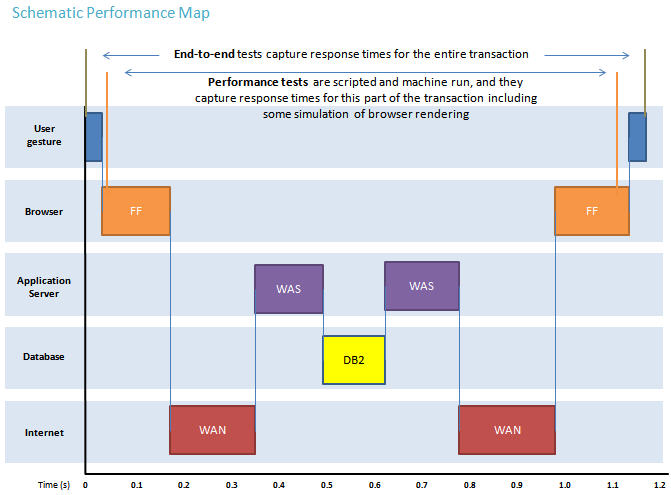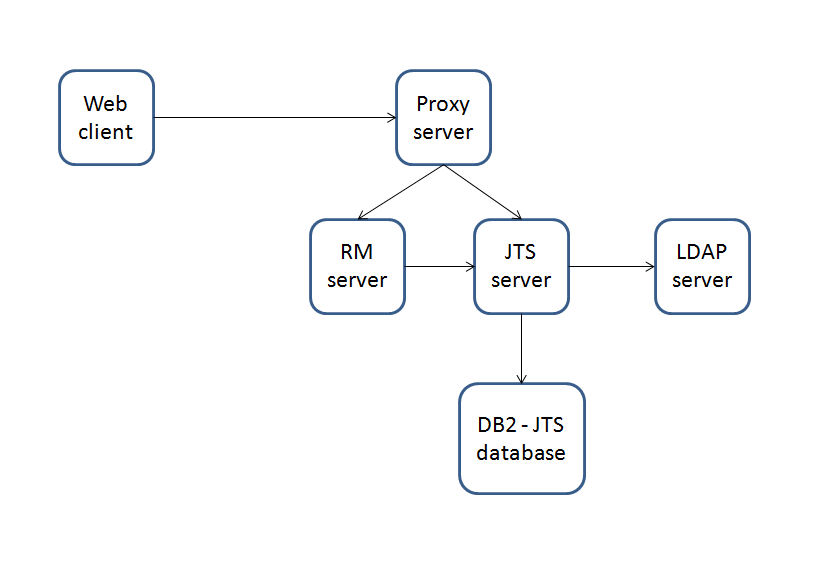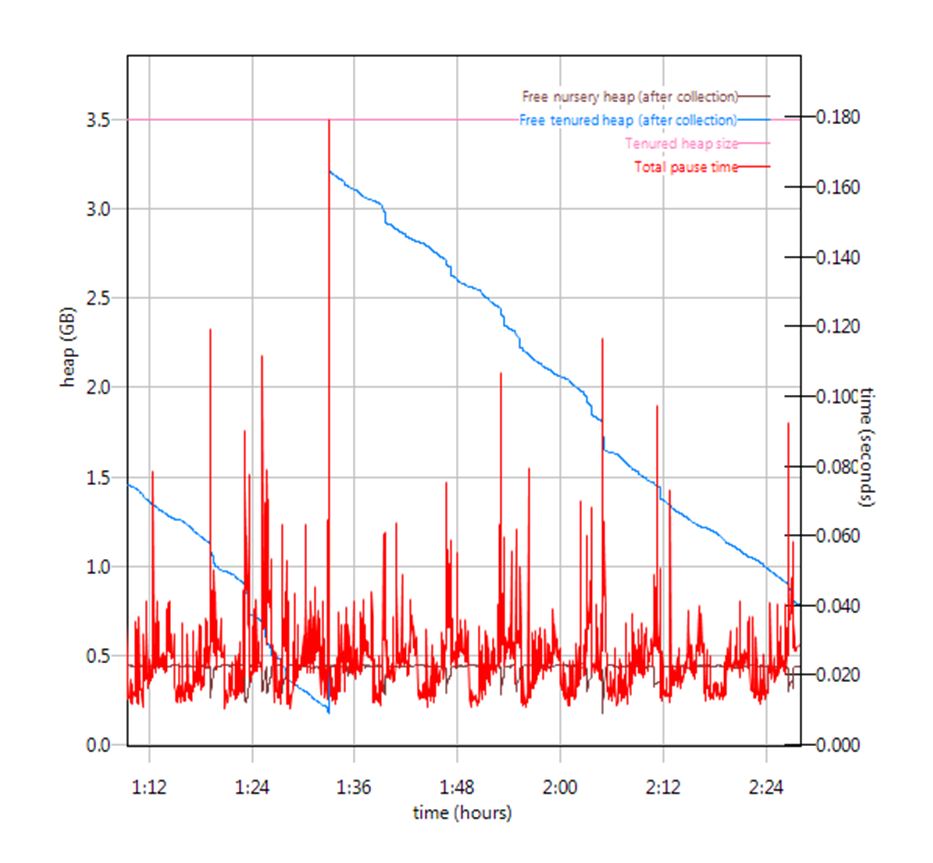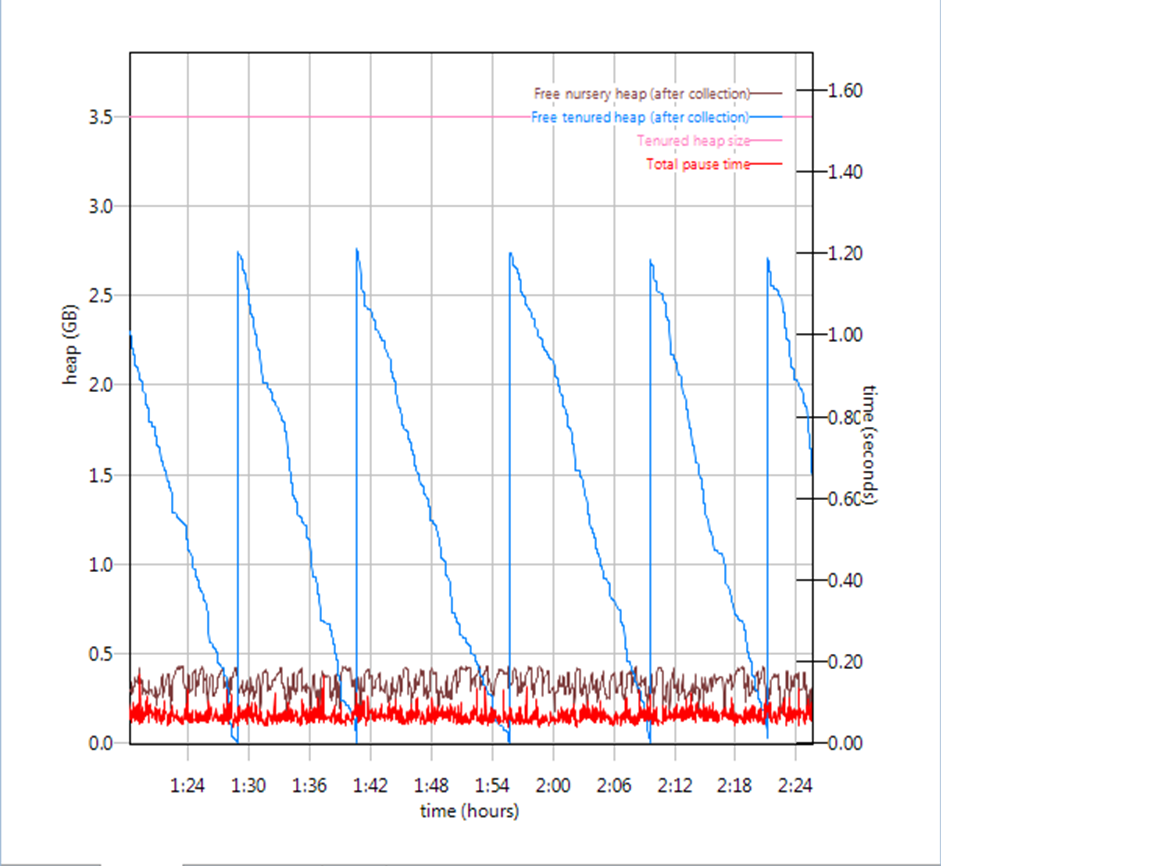Introduction
This report compares the performance of an unclustered Rational
Requirements Composer version 4.0.4 deployment to the previous 4.0.3
release. The test objective is achieved in three steps:
- Run version 4.0.3 with standard 1-hour test using 400 concurrent users.
- Run version 4.0.4 with standard 1-hour test using 400 concurrent users.
- The test is run three time for each version and the resulting six tests are compared with each other. Three tests per version is used to get a more accurate picture since there are variations expected between runs.
Disclaimer
The information in this document is distributed AS IS. The use of this information or the implementation of any of these techniques is a customer responsibility and depends on the customerís ability to evaluate and integrate them into the customerís operational environment. While each item may have been reviewed by IBM for accuracy in a specific situation, there is no guarantee that the same or similar results will be obtained elsewhere. Customers attempting to adapt these techniques to their own environments do so at their own risk. Any pointers in this publication to external Web sites are provided for convenience only and do not in any manner serve as an endorsement of these Web sites. Any performance data contained in this document was determined in a controlled environment, and therefore, the results that may be obtained in other operating environments may vary significantly. Users of this document should verify the applicable data for their specific environment.
Performance is based on measurements and projections using standard IBM benchmarks in a controlled environment. The actual throughput or performance that any user will experience will vary depending upon many factors, including considerations such as the amount of multi-programming in the userís job stream, the I/O configuration, the storage configuration, and the workload processed. Therefore, no assurance can be given that an individual user will achieve results similar to those stated here.
This testing was done as a way to compare and characterize the differences in performance between different versions of the product. The results shown here should thus be looked at as a comparison of the contrasting performance between different versions, and not as an absolute benchmark of performance.
What our tests measure
We use predominantly automated tooling such as Rational Performance Tester (RPT) to simulate a workload normally generated by client software such as the Eclipse client or web browsers. All response times listed are those measured by our automated tooling and not a client.
The diagram below describes at a very high level which aspects of the entire end-to-end experience (human end-user to server and back again) that our performance tests simulate. The tests described in this article simulate a large part of the end-to-end transaction as indicated. Performance tests include some simulation of browser rendering and network latency between the simulated browser client and the application server stack.

Findings
Performance goals
- Verify that there are no performance regressions between current release and prior release with 400 concurrent users using the workload described below.
Findings
- RPT report shows similar response times for 4.0.4 and 4.0.3.
- In 4.0.4 many actions are slightly faster than in 4.0.3.
- Comparing nmon data for both 4.0.4 and 4.0.3 show similar CPU, memory and disk utilization on application servers and database server.
Topology
The topology under test is based on
Standard Topology (E1) Enterprise - Distributed / Linux / DB2.

The specifications of machines under test are listed in the table below. Server tuning details listed in
*Appendix A*
| Function |
Number of Machines |
Machine Type |
CPU / Machine |
Total # of CPU Cores/Machine |
Memory/Machine |
Disk |
Disk capacity |
Network interface |
OS and Version |
| IBM HTTP Server and WebSphere Plugin |
1 |
IBM System x3250 M4 |
1 x Intel Xeon E3-1240 3.4GHz (quad-core) |
8 |
16GB |
RAID 1 -- SAS Disk x 2 |
279GB |
Gigabit Ethernet |
Red Hat Enterprise Linux Server release 6.3 (Santiago) |
| JTS Server |
1 |
IBM System x3550 M4 |
2 x Intel Xeon E5-2640 2.5GHz (six-core) |
24 |
32GB |
RAID 5 -- SAS Disk x 4 |
279GB |
Gigabit Ethernet |
Red Hat Enterprise Linux Server release 6.3 (Santiago) |
| RRC Server |
1 |
IBM System x3550 M4 |
2 x Intel Xeon E5-2640 2.5GHz (six-core) |
24 |
32GB |
RAID 5 -- SAS Disk x 4 |
279GB |
Gigabit Ethernet |
Red Hat Enterprise Linux Server release 6.3 (Santiago) |
| Database Server |
1 |
IBM System x3650 M4 |
2 x Intel Xeon E5-2640 2.5GHz (six-core) |
24 |
64GB |
RAID 10 -- SAS Disk x 16 |
279GB |
Gigabit Ethernet |
Red Hat Enterprise Linux Server release 6.3 (Santiago) |
| RPT Workbench |
1 |
VM image |
2 x Intel Xeon X7550 CPU (1-Core 2.0GHz 64-bit) |
2 |
6GB |
SCSI |
80GB |
Gigabit Ethernet |
Microsoft Windows Server 2003 R2 Standard Edition SP2 |
| RPT Agent |
1 |
xSeries 345 |
4 x Intel Xeon X3480 CPU (1-Core 3.20GHz 32-bit) |
4 |
3GB |
SCSI |
70GB |
Gigabit Ethernet |
Microsoft Windows Server 2003 Enterprise Edition SP2 |
| RPT Agent |
1 |
xSeries 345 |
4 x Intel Xeon X3480 CPU (1-Core 3.20GHz 32-bit) |
4 |
3GB |
RAID 1 - SCSI Disk x 2 |
70GB |
Gigabit Ethernet |
Microsoft Windows Server 2003 Enterprise Edition SP2 |
| RPT Agent |
1 |
Lenovo 9196A49 |
1 x Intel Xeon E6750 CPU (2-Core 2.66GHz 32-bit) |
2 |
2GB |
SATA |
230GB |
Gigabit Ethernet |
Microsoft Windows Server 2003 Enterprise Edition SP2 |
| Network switches |
N/A |
Cisco 2960G-24TC-L |
N/A |
N/A |
N/A |
N/A |
N/A |
Gigabit Ethernet |
24 Ethernet 10/100/1000 ports |
N/A: Not applicable.
Network connectivity
All server machines and test clients are located on the same subnet. The LAN has 1000 Mbps of maximum bandwidth and less than 0.3ms latency in ping.
Data volume and shape
The artifacts were distributed between 40 small projects, 10 medium projects and one large project for a total of 200,589 artifacts.
The repository contained the following data:
- 141 modules
- 14,500 module artifacts
- 3,203 folders
- 434 collections
- 274 reviews
- 40,798 comments
- 520 public tags
- 110 private tags
- 15,350 terms
- 22,778 links
- 360 views
- Database size = 20 GB
- JTS index size = 9 GB
The large project contained the following data:
- 11 modules
- 1,160 folders
- 78,842 requirement artifacts
- 106 collections
- 64 reviews
- 16,897 comments
- 300 public tags
- 50 private tags
- 9,006 terms
- 15,594 links
- 200 views
Methodology
Rational Performance Tester was used to simulate the workload created using the
web client. Each user completed a random use case from a set of
available use cases. A Rational Performance Tester script is created for
each use case. The scripts are organized by pages and each page
represents a user action.
Based on real customer use, the test scenario provides a ratio of 70% reads
and 30% writes. The users completed use cases at a rate of 30 pages per
hour per user. Each performance test runs for 60 minutes after all of
the users are activated in the system.
Test cases and workload characterization
Response time comparison
The median response time provided more even results than the average
response time. The nature of the high variance between tests where
some tasks at time takes a longer time to run, such as when the server
is under heavy load, makes the average response time less
predictive. Both the median and average values are included in the
following tables and charts for comparison.
In the repository that contained 200,000 artifacts with 400 concurrent
users, no obvious regression was shown when comparing response times
between runs.
The numbers in the following charts include all of the pages for all of the scripts that ran.
Results

 Garbage collection
Garbage collection
Verbose garbage collection is enable to create the GC logs. The GC logs shows very little variation between runs. There is also no discernible difference between versions . Below is one example of the output from the GC log for each application.
RM
 JTS
JTS

Create a collection
 Back to Test Cases & workload characterization
Back to Test Cases & workload characterization
Filter a query
 Back to Test Cases & workload characterization
Back to Test Cases & workload characterization
Open nested folders
 Back to Test Cases & workload characterization
Back to Test Cases & workload characterization
Manage folders
 Back to Test Cases & workload characterization
Back to Test Cases & workload characterization
Query by ID
 Back to Test Cases & workload characterization
Back to Test Cases & workload characterization
View collections
 Back to Test Cases & workload characterization
Back to Test Cases & workload characterization
Check suspect links
 Back to Test Cases & workload characterization
Back to Test Cases & workload characterization
Add comments to an artifact
 Back to Test Cases & workload characterization
Back to Test Cases & workload characterization
Open the project dashboard
 Back to Test Cases & workload characterization
Back to Test Cases & workload characterization
Create a multi-value artifact
 Back to Test Cases & workload characterization
Back to Test Cases & workload characterization
Create an artifact
 Back to Test Cases & workload characterization
Back to Test Cases & workload characterization
Show artifacts in a Tree view
 Back to Test Cases & workload characterization
Back to Test Cases & workload characterization
Open graphical artifacts
 Back to Test Cases & workload characterization
Back to Test Cases & workload characterization
Create and edit a storyboard
 Back to Test Cases & workload characterization
Back to Test Cases & workload characterization
Display the hover information for a collection
 Back to Test Cases & workload characterization
Back to Test Cases & workload characterization
Query by string
 Back to Test Cases & workload characterization
Back to Test Cases & workload characterization
Create a PDF report
 Back to Test Cases & workload characterization
Back to Test Cases & workload characterization
Create a Microsoft Word report
 Back to Test Cases & workload characterization
Back to Test Cases & workload characterization
Appendix A
Product
|
Version |
Highlights for configurations under test |
| IBM HTTP Server for WebSphere Application Server |
8.5.0.1 |
IBM HTTP Server functions as a reverse proxy server implemented
via Web server plug-in for WebSphere Application Server. Configuration details can be found from the CLM infocenter.
HTTP server (httpd.conf):
Web server plugin-in (plugin-cfg.xml):
OS Configuration:
- max user processes = unlimited
|
| IBM WebSphere Application Server Network Deployment | 8.5.0.1 | JVM settings:
- GC policy and arguments, max and init heap sizes:
-XX:MaxDirectMemorySize=1g -Xgcpolicy:gencon -Xmx4g -Xms4g -Xmn512m -Xcompressedrefs -Xgc:preferredHeapBase=0x100000000
Thread pools:
- Maximum WebContainer = Minimum WebContainer = 500
OS Configuration:
System wide resources for the app server process owner:
- max user processes = unlimited
- open files = 65536
|
| DB2 |
DB2 10.1 |
|
| LDAP server |
|
|
| License server |
|
Hosted locally by JTS server |
| RPT workbench |
8.2.1.5 |
Defaults |
| RPT agents |
8.2.1.5 |
Defaults |
| Network |
|
Shared subnet within test lab |
For more information
About the authors
GustafSvensson
Questions and comments:
- What other performance information would you like to see here?
- Do you have performance scenarios to share?
- Do you have scenarios that are not addressed in documentation?
- Where are you having problems in performance?
Warning: Can't find topic Deployment.PerformanceDatasheetReaderComments

 The specifications of machines under test are listed in the table below. Server tuning details listed in *Appendix A*
The specifications of machines under test are listed in the table below. Server tuning details listed in *Appendix A*

 Garbage collection
Verbose garbage collection is enable to create the GC logs. The GC logs shows very little variation between runs. There is also no discernible difference between versions . Below is one example of the output from the GC log for each application.
RM
Garbage collection
Verbose garbage collection is enable to create the GC logs. The GC logs shows very little variation between runs. There is also no discernible difference between versions . Below is one example of the output from the GC log for each application.
RM
 JTS
JTS
 Create a collection
Create a collection
 Back to Test Cases & workload characterization
Filter a query
Back to Test Cases & workload characterization
Filter a query
 Back to Test Cases & workload characterization
Open nested folders
Back to Test Cases & workload characterization
Open nested folders
 Back to Test Cases & workload characterization
Manage folders
Back to Test Cases & workload characterization
Manage folders
 Back to Test Cases & workload characterization
Query by ID
Back to Test Cases & workload characterization
Query by ID
 Back to Test Cases & workload characterization
View collections
Back to Test Cases & workload characterization
View collections
 Back to Test Cases & workload characterization
Check suspect links
Back to Test Cases & workload characterization
Check suspect links
 Back to Test Cases & workload characterization
Add comments to an artifact
Back to Test Cases & workload characterization
Add comments to an artifact
 Back to Test Cases & workload characterization
Open the project dashboard
Back to Test Cases & workload characterization
Open the project dashboard
 Back to Test Cases & workload characterization
Create a multi-value artifact
Back to Test Cases & workload characterization
Create a multi-value artifact
 Back to Test Cases & workload characterization
Create an artifact
Back to Test Cases & workload characterization
Create an artifact
 Back to Test Cases & workload characterization
Show artifacts in a Tree view
Back to Test Cases & workload characterization
Show artifacts in a Tree view
 Back to Test Cases & workload characterization
Open graphical artifacts
Back to Test Cases & workload characterization
Open graphical artifacts
 Back to Test Cases & workload characterization
Create and edit a storyboard
Back to Test Cases & workload characterization
Create and edit a storyboard
 Back to Test Cases & workload characterization
Display the hover information for a collection
Back to Test Cases & workload characterization
Display the hover information for a collection
 Back to Test Cases & workload characterization
Query by string
Back to Test Cases & workload characterization
Query by string
 Back to Test Cases & workload characterization
Create a PDF report
Back to Test Cases & workload characterization
Create a PDF report
 Back to Test Cases & workload characterization
Create a Microsoft Word report
Back to Test Cases & workload characterization
Create a Microsoft Word report
 Back to Test Cases & workload characterization
Back to Test Cases & workload characterization